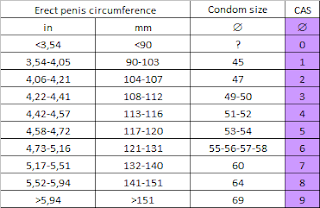Condom and penis size match
As explained by Gerofi (
http://www.enersol.com.au/CondomSize.pdf), the condom
effectiveness depends on a number of factors, of which the three most important are:
1. The condom should be used
2. The condom should not break
3. The condom should not slip off during use.
The actual pressure and force on the penis depends on the relative circumferences of the penis and condom, the thickness of the rubber, and its elastic modulus.
So the thickness of the rubber and its elastic modulus being constant, the determination of the correct size depends only on the ratio between the penis and condom circumference. It has to be so that it is not unduly stretched (not comfortable), nor too loose (the pressure from the condom on the penis is not high enough, and the condom will slip).
The text below from the Condomerie Web site (Condomerie CAS Index) proves the consensus in the scientific community:
The most important thing when looking for the best fit is the condom's circumference. A condom that's too large can easily slip off, but a condom that is too tight is uncomfortable and the risk of tearing is greater. The length of the condom isn't as important, but should be as close to the length of the penis as possible. The condom's thickness and elasticity can also make it less or more comfortable.
Below is the chart of circumference ratios for the actual existing condom sizes:**
*The condom size is often called the diameter, but in fact it is the semi-perimeter (width when flat). A 53mm condom is in fact a condom of 106mm circumference (33.74mm diameter).
**Each line of the chart corresponds to the ratio between the condom circumference and the average circumference of the scientific study.
The chart shows that a man with a 122mm circumference erect penis (Janssen study average) can use safely condoms of sizes 52, 53, 54 and 55. With a 52 one, it will be safer (no slippage risk whatsoever), but not as comfortable as a 55 one (but more risk of slippage).
This chart proves at least one thing: the manufacturers perfectly know the average erect penis circumference, because their standard size (52-53) are a perfect fit for the "standard" penis. Indeed following Gerofi analysis, the perfect ratio ranges between 10% and 20%.
Below 10%, the risk of slippage increases slowly until 5% then drastically. Especially because the erect penis is not always at its maximum erection level (level often measured by men).
Above 20%, discomfort feeling increases until 30% where the risk of breakage increases.
Following the same rule, here is a simplified matching table between condom and penis size:
Find your erect penis circumference in the proposed ranges, and simply pick the condom sizes that fit you well.
For example, a man with an erect penis circumference of 5.2in could use any condom whose size is between 2.20 and 2.36in (flat width). A man with an erect penis circumference of 127mm could use any condom whose size is between 54 and 57mm (flat width).
References:
Anthony M A Smith, Damien Jolley, Jane Hocking, Kim Benton and John Gerofi." 8 444-447































